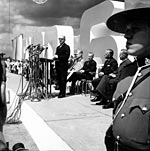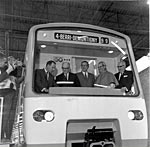

Jean Drapeau, between modernism and tradition
The fact that executive committee members were chosen by the mayor ensured the creation of a more homogeneous, stable and efficient team. The mayor thus assumed greater importance, working in close collaboration with the chairman of the executive committee. That system also favored the development of in tandem management, which remains unchallenged to this day.
Over the course of his long career, Jean Drapeau had the wisdom to surround himself with competent administrators. In 1962, he worked in tandem with Lucien Saulnier, who sat in city council in 1954. Saulnier headed the Civic Action League until 1960, thus gaining wide experience in local political life. He was also a founding member of the Civic Party.
Mayor Jean Drapeau embarked on an ambitious reform program, in keeping with his far-reaching views of Montréal, whose influence should be felt throughout the world. He favored the growth, transformation and modernization of the downtown core in the 1960s, and fostered the development of large-scale major projects to boost the city’s prestige.
In 1966, Jean Drapeau inaugurated the Montréal Métro. The following year, millions of tourists flocked to Montréal for Expo 67.
All those achievements bear eloquent witness to the popularity of a mayor who put Montréal on the world map. He had attained the status of a true hero and was at the peak of his political career in the 1960s. His style of leadership was unique, and he was the epitome of stability and authority. But on the other hand, the centralized type of government he favored led to a certain deterioration of democratic life.
During the 1960s, the number of independent councillors greatly reduced. They represented a third in 1960, then went from six in 1962 down to three in 1966. Voter turnout was also quite low, roughly 40%. In 1966, it was a mere 30%.
The Civic Party consisted of a select group of councillors and its member recruiting methods created a hierarchical power structure. Most members were administrators and merchants chosen by Jean Drapeau himself. There was an air of secrecy about everything since there were no militants in the group. Executive committee members and councillors were required to be in complete accord and deliberations were out of the question. Under those circumstances, it is understandable that city council meetings did not arouse the interest of citizens.
In the 1970s, the tide had turned and the mayor could not easily maintain that type of unanimity. On the local scene, there were opposition movements, and the astronomical increase in Olympic installation costs was a major cause of discontent and unrest. In the summer of 1976, the opening of the XXI Olympics briefly revived the optimism displayed in the sixties.



































